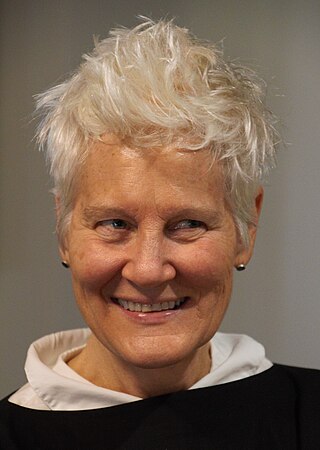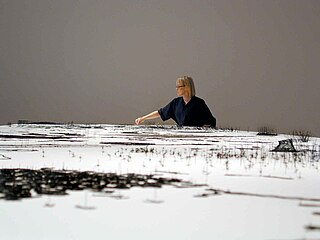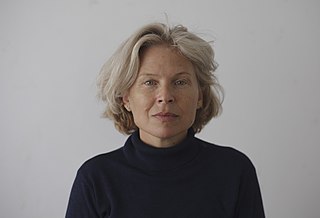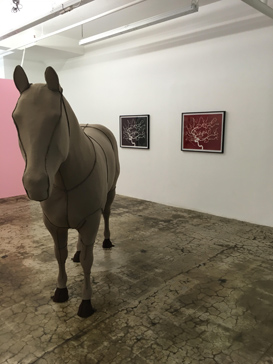Dorothy Cross is an Irish artist. Working with differing media, including sculpture, photography, video and installation, she represented Ireland at the 1993 Venice Biennale. Central to her work as a whole are themes of sexual and cultural identity, personal history, memory, and the gaps between the conscious and subconscious. In a 2009 speech by the president of UCC, Cross was described as "one of Ireland’s leading artists".

Helen Chadwick was a British sculptor, photographer and installation artist. In 1987, she became one of the first women artists to be nominated for the Turner Prize. Chadwick was known for "challenging stereotypical perceptions of the body in elegant yet unconventional forms. Her work draws from a range of sources, from myths to science, grappling with a plethora of unconventional, visceral materials that included chocolate, lambs tongues and rotting vegetable matter. Her skilled use of traditional fabrication methods and sophisticated technologies transform these unusual materials into complex installations. Maureen Paley noted that "Helen was always talking about craftsmanship—a constant fount of information". Binary oppositions was a strong theme in Chadwick's work; seductive/repulsive, male/female, organic/man-made. Her combinations "emphasise yet simultaneously dissolve the contrasts between them". Her gender representations forge a sense of ambiguity and a disquieting sexuality blurring the boundaries of ourselves as singular and stable beings."

Aino Maria Marsio-Aalto was a Finnish architect and a pioneer of Scandinavian design. She is known as a co-founder of the design company Artek and as a collaborator on its most well-known designs. As Artek's first artistic director, her creative output spanned textiles, lamps, glassware, and buildings. It has been discovered that it was Aino who completed the first work commissioned through Artek which was the Viipuri Library in 1935. Her work is in the permanent collection of the Museum of Modern Art (MoMA) in New York, and MoMA has included her work in nine exhibitions. Aino Aalto’s first exhibition was Art in Progress: 15th Anniversary Exhibitions: Design for Use at MoMA in 1944. Other major exhibitions were at the Barbican Art Gallery in London and Chelsea Space in London. Aino Aalto has been exhibited with Pablo Picasso.
Tara Donovan is an American sculptor who lives and works in Brooklyn, New York. Her large-scale installations, sculptures, drawings, and prints utilize everyday objects to explore the transformative effects of accumulation and aggregation. Known for her commitment to process, she has earned acclaim for her ability to exploit the inherent physical characteristics of an object in order to transform it into works that generate unique perceptual phenomena and atmospheric effects. Her work has been conceptually linked to an art historical lineage that includes Postminimalism and Process artists such as Eva Hesse, Jackie Winsor, Richard Serra, and Robert Morris, along with Light and Space artists such as Mary Corse, Helen Pashgian, Robert Irwin, and James Turrell.

Ann Hamilton is an American visual artist who emerged in the early 1980s known for her large-scale multimedia installations. After receiving her BFA in textile design from the University of Kansas in 1979, she lived in Banff, Alberta, and Montreal, Quebec, Canada before deciding to pursue an MFA in sculpture at Yale in 1983. From 1985 to 1991, she taught on the faculty of the University of California at Santa Barbara. Since 2001, Hamilton has served on the faculty of the Department of Art at the Ohio State University. She was appointed a Distinguished University Professor in 2011.

Doris Salcedo is a Colombian-born visual artist and sculptor. Her work is influenced by her experiences of life in Colombia and is generally composed of commonplace items such as wooden furniture, clothing, concrete, grass, and rose petals. Salcedo's work gives form to pain, trauma, and loss, while creating space for individual and collective mourning. These themes stem from her own personal history. Members of her own family were among the many people who have disappeared in politically troubled Colombia. Much of her work deals with the fact that, while the death of a loved one can be mourned, their disappearance leaves an unbearable emptiness. Salcedo lives and works in Bogotá, Colombia.

Bharti Kher is a contemporary artist. In a career spanning nearly three decades, she has worked across painting, sculpture and installation. Throughout her practice she has displayed an unwavering relationship with the body, its narratives, and the nature of things. Inspired by a wide range of sources and making practices, she employs the readymade in wide arc of meaning and transformation. Kher's works thus appear to move through time, using reference as a counterpoint and contradiction as a visual tool.

Anne Wilson is a Chicago-based visual artist. Wilson creates sculpture, drawings, Internet projects, photography, performance, and DVD stop motion animations employing table linens, bed sheets, human hair, lace, thread and wire. Her work extends the traditional processes of fiber art to other media. Wilson is a professor in the Department of Fiber and Material Studies at The School of the Art Institute of Chicago.

Naihan Li is a Chinese designer architect. She currently lives and works in Beijing in the Caochangdi Art District.

Sigalit Landau is an Israeli sculptor, video and installation artist.
Victimless Leather (2004) is an art piece that represents a leather jacket without killing any animals. It is a prototype of a stitch-less jacket, grown from cell cultures into a layer of tissue supported by a coat shaped polymer layer. "Victimless Leather" was created created as a sub-project of the Tissue Culture & Art Project, from the University of Western Australia and showcased at the Museum of Modern Art in New York. The artwork, a miniature jacket made from living mouse stem cells in an incubator, was designed to challenge perceptions of life and human responsibility toward manipulated living systems. This artistic grown garment is intended to confront people with the moral implications of wearing parts of dead animals for protective and aesthetic reasons and confronts notions of relationships with manipulated living systems. However, due to rapid cell growth, the exhibit was eventually "killed" by cutting off its nutrients, aligning with the creators' intent to remind viewers of the responsibility towards manipulated life.
Liz Larner is an American installation artist and sculptor living and working in Los Angeles.

Hella Jongerius is a Dutch industrial designer.
Sheela Gowda is a contemporary artist living and working in Bangalore. Gowda studied painting at Ken School of Art, Bangalore, India (1979) pursued a postgraduate diploma at Visva-Bharati University, Santiniketan, India (1982), and a MA in painting from the Royal College of Art in London in 1986. Trained as a painter Gowda expanded her practice into sculpture and installation employing a diversity of material like human hair, cow-dung, incense and kumkuma powder. She is known for her 'process-orientated' work, often inspired by the everyday labor experiences of marginalized people in India. Her work is associated with postminimalism drawing from ritualistic associations. Her early oils with pensive girls in nature were influenced by her mentor K. G. Subramanyan, and later ones by Nalini Malani towards a somewhat expressionistic direction depicting a middle class chaos and tensions underplayed by coarse eroticism. She is the recipient of the 2019 Maria Lassnig Prize.

Marguerite Humeau is a French visual artist. She lives in London.
Suzanne Anker is an American visual artist and theorist. Considered a pioneer in Bio Art., she has been working on the relationship of art and the biological sciences for more than twenty five years. Her practice investigates the ways in which nature is being altered in the 21st century. Concerned with genetics, climate change, species extinction and toxic degradation, her work calls attention to the beauty of life and the "necessity for enlightened thinking about nature's 'tangled bank'." Anker frequently assembles with "pre-defined and found materials" botanical specimens, medical museum artifacts, laboratory apparatus, microscopic images and geological specimens.
Liz Collins is an American contemporary artist and designer. Collins is recognized for her artwork involving fabric, knitwear, and textiles as well as the fashion label she developed. She has expertise in textile media including the transition of fabric into multi-dimensional forms as a method to vary the scale of her pieces to make them architectural and inviting rather than object-based. Collins is based in Brooklyn, New York.

Julia deVille is a New Zealand-born artist, jeweller and taxidermist, who only uses subjects in her taxidermy that have died of natural causes. She lives and works in Australia.
Vegan design is the use of vegan products in such contexts as interior design, fashion design, household goods and the arts. Such products are also known as "humane" or "cruelty-free" and "[do] not originate from any living creature, [are] not an animal byproduct and [are] not tested on animals".

Liz Young was a Los Angeles-based artist known for diverse work investigating body- and nature-focused themes, such as loss, beauty, the inevitability of decay, and the fragility of life. She produced sculpture, installation, performance, painting, drawing and video incorporating fabricated and recontextualized found objects, organic materials, and processes from industrial metalworking to handicrafts, taxidermy and traditional art practices. Young exhibited throughout the United States and Europe, including solo shows at the Los Angeles County Museum of Art (LACMA) and Los Angeles Contemporary Exhibitions (LACE), and alternative spaces such as Hallwalls, Randolph Street Gallery (Chicago) and New Langton Arts ; she participated in group shows at Exit Art, Art in the Anchorage, and Armory Center for the Arts, among others. Her art was discussed in ARTnews, Artforum, Frieze, Los Angeles Times, The New York Times, and The Village Voice, and is included in the LACMA permanent collection. Critic Peter Frank wrote that her work "reflects both on life's relentless erosion of body and spirit, and on our indomitable struggle against these nagging cruelties." Artillery Magazine critic Ezrha Jean Black called her 2017 installation a "mordant yet elegiac show" in which "craft bears out the work’s consciousness." In 2016, Young received a Guggenheim Foundation Fellowship; she was recognized with awards from the Getty Trust and Andy Warhol Foundation, among others. Young lived and worked in Los Angeles from 1981.











